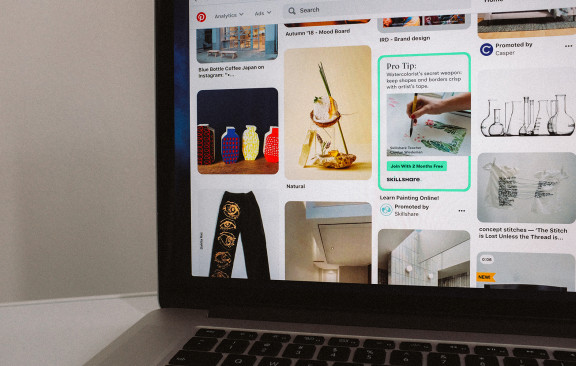Everyone knows that social media is becoming a force to be reckoned with in eCommerce. Everyone isn't quite so knowledgeable, however, about some of the newer players in the game. Pinterest, in particular, is making enormous waves in the world of social commerce.
In fact, there's almost no better way to draw a unique and ideally suited audience to your eCommerce site than by pinning your pages on Pinterest. Not only that, but the social network's market share is growing quickly. Faster, in fact, than either Facebook or Twitter did during the same time period in their history.
Pinterest background
Speaking of history, let's examine the humble beginnings of this newest force in the e-commerce world. Pinterest's founder, Ben Silbermann, began developing the site in December 2009. To gather support, Silbermann personally wrote to the first 5,000 users to sign up for the site. He even gave a few his personal phone number.
He did all of this work out of a small apartment until the summer of 2011. After that, he needed just a bit more space to accommodate his needs. By January of 2012, the site had 11.7 million unique visitors. It's the fastest site in history to break the 10-million-unique-visitor mark.
Pinterest as an eCommerce platform
Pinterest is being used as a social marketing tool by online stores around the world, now more than ever. And the numbers are only trending upward, with no plateau in sight. As of March 26, 2014, there are more than 70 million Pinterest users across the globe.
According to Media Bistro, 69 percent of Pinterest users have found an item that they wanted to purchase.This is an astounding statistic when you consider the fact that Pinterest is meant to be a social media platform, not a comparison shopping engine.
What really sets Pinterest apart from other social media giants like Facebook or Twitter though, is the shelf life of posts. Pinterest images have staying power. The pins you put up for your products are likely to be re-pinned even after a year has gone by, whereas the average time a post or tweet stays relevant is around two hours.
To further illustrate the advertising power of the platform, consider the following graph, which shows how often shoppers find an item that interests them, eventually leading to a purchase.
Pinterest continues to gain a larger share of the social media market, which is worth repeating because shoppers coming to your e-commerce site from this network are at least 10 percent more likely to spend money upon arrival than those who come from any other social platform.
Factors that help Pinterest drive traffic to eCommerce sites
Pinterest has a lot going for it. One of its newest features, "rich pins," basically serve as on-site product pages. These allow users to directly act on the pins, usually clicking through to the product page on your site. You can pin both products and product reviews as well. The network also recently added functionality that allows brands to highlight product details such as pricing updates and where to purchase.
Beyond these convenient funnels to your e-commerce site, Pinterest has also made products easily pinnable. Whenever you put a pin on a product, that pin will link back to the original source.
Additionally, you can add another link in the pin's description. Adding a high-quality, persuasive description and linking back to your product page is a great way to convince social media users to become visitors, and for visitors to become buyers. There's even a price filter feature on Pinterest that selects only products that fall within a certain price range for placement in user feeds.
Finally, Pinterest also has an analytics system that gives users unique insights into visitor behavior, and helps them form a pinning strategy. The Pinterest price bubble, for example, sends your followers notifications when a pinned product drops in price.
How Pinterest is different from other social media
Most social media platforms are best suited to, well, socializing. Pinterest, on the other hand, seems like it was tailor made for marketers. People go to Pinterest for inspiration, news, and a lot of shopping. They find unique and interesting new products within their favorite niches.
As I mentioned earlier, the site's pins last much longer than the posts on most other social media platforms, and this gives it a major competitive edge in that respect. But perhaps most telling of the unique advertising power of Pinterest is that 70 percent of its users browse the site to get information on new products that just hit their market of choice.
Using Pinterest to drive traffic to your eCommerce site
Now that you understand Pinterest's viability as a social commerce platform, let's talk about how you can influence your market by using Pinterest.
Once you set up a Pinterest account, the platform recommends posts for you to follow. Leverage this function by listing all of your products with powerfully persuasive descriptions and high-quality imagery. Put your best foot forward and users will repin your pins to their boards.
Once they click on your pin, they are redirected to your e-commerce site for the purchase.
The Pinterest process
To further funnel your social fans into e-commerce site traffic, you should make boards that highlight your best-selling products. You should also create the pins with the viral nature of the Internet in mind. Create gripping headlines to pair with the images to help sell the products.
And as I mentioned before, definitely place a copy of the product page's URL in the description of the pin. Most people will click through on the image, but there's no reason not to make the description clickable as well.
Most importantly, be certain that there is always a "Pin it" button for all of your products on your site. This lets users share what they find and like more easily. That's more promotion that you don't have to do any work for.
One more thing to consider: Pinterest is extremely popular for mobile browsing, so be certain optimize your site for mobile content as well. Just look at how often Pinterest users are browsing via the smartphone app.
Pinterest is a leading social platform in terms of marketing potential, and this is a fact that hasn't been ignored by major franchises. In fact, some companies have started leaking Black Friday ads to the site months ahead of schedule.
This unique position that it holds within the market creates a somewhat symbiotic relationship between the site and the various brands that advertise within it. Pinterest receives increased credibility, and the brands get access to their target markets almost effortlessly.
Pinterest users see the site as a go-to place for trending items in the market, regardless of the actual product. And it's this "it" factor that has allowed Pinterest to take over a larger share of the social media craze than most. The average Pinterest user is more likely to buy online and then, in turn, to spend more money while on your site.
Up-sell, cross-sell, etc. You know the drill.
Have you had any success advertising your products on Pinterest? Tell us all about it in the comments section.










